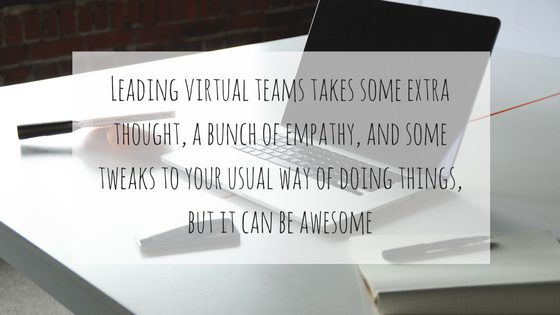One of the common complaints I hear from leaders is that they “can’t” practice great leadership with their teams because they are located in different places. I have to call BS on this. Leading virtual teams takes some extra thought, a bunch of empathy, and some tweaks to your usual way of doing things, but it can be awesome. Here are some tips that work.
Use video calling rather than phone calls whenever possible.
For some reason, this seems overly difficult in many of my clients’ offices. I’m not sure how their software and equipment has complicated simple video-calling, but it has. My clients complain that only one meeting room allows for video calling, or that the software the company uses doesn’t work on their laptop. If this is a problem in your office, go around it. Skype, google hangouts, gotomeeting and many, many other softwares are super simple to use. They provide options for sharing screens, and you and your virtual team members can benefit from a much richer discussion, with facial expressions and body language adding to the context.
 Pay close attention to time zones.
Pay close attention to time zones.
Time zones can be difficult to work around, especially when there is a wide gap between business hours. For starters, make sure you have a clock set to the various time zones you deal in. iPhones have a World Clock that makes this very simple. When you’re scheduling meetings, take one for the team. Schedule some of the meetings in an inconvenient time for yourself rather than those on the other side of the globe. When you’re sending emails, realize that they may be hitting your team’s inboxes late in the day. Set clear expectations around when they need to be responded to. It’s up to your team to manage their time, but the false urgency of email notifications often leads to people feeling like they are not in control of their time, which is very disengaging.
If you must use conference calls, practice proper etiquette.
If you haven’t seen this video, watch it and consider your last conference call. I’ll bet you can relate to almost every painful part of this real life conference call.
Set some parameters for conference calls and model them. A few to ensure:
- No side conversations. These often happen when there is a group of people in one office, participating together. They are extremely annoying for virtual team members.
- Map out the attendees as though they were in a physical room. I draw a table, put names around the table as people join, and check off participation as they do.
- Have an “on deck” system for giving people a heads up that you’ll be asking for their input. This way, they can unmute themselves and be prepared when you go to them.
- Make a point of asking everyone on the call for their input.
- Limit the time and number of attendees.
- This is just like a real meeting. That means it’s not time to check email, get other work done, or be on other calls at the same time.
- If the call is just a status update, challenge whether it needs to be a call. Can you send an email instead, or use collaborative project software to share updates?
What other parameters would you put in place in order to optimize your conference call? I’d love to hear in the comments!
Have feedback conversations regularly.
So often, we think of feedback only occurring when something has gone wrong. We get pulled into the manager’s office, the door is closed, and we receive “constructive feedback.” We believe in feedback happening all the time, so that it’s not an intimidating process, and feedback isn’t stored up until the situation is critical. We teach our culture of feedback discussions – which are two-way and employee-first – in our Leadership Development program, but regardless of what process you follow, do it often – like every week if possible. Look for things to discuss that could have been done more effectively, or things that exceeded expectations.
Starting feedback with questions is especially important for virtual workers. You don’t see most of what they do, so ask them what they’re proud of, what they had challenges with, and what they would have done differently on a regular basis. They know better than you do what feedback they need, so let them guide these discussions.
Get to know your team as humans.
When people are not working in the same location, they miss out on the water cooler discussions and “how was your weekend” conversations that happen informally face to face. Make time for these discussions as often as possible. With our Blue Rebel team, we work almost entirely virtually. In our weekly team meeting video calls, we start with an icebreaker question every time. We’ve asked questions like “What’s the biggest challenge you had growing up?” to “If you were stranded on a desert island, what three items would you want with you?” and “Who was your role model as a child and why?”
Although we have only met in person 3-4 times, we feel very close and have gotten to know a lot about each other’s families, passions and daily habits. In the past, I’ve made the mistake of skipping this step, and work stopped being fun. I won’t make that mistake again.
When you lead people, it’s your responsibility to do what you can to engage them. The onus is on you to build relationships with virtual workers. You should be the first to sacrifice time and attention to benefit the team, not the other way around. Leading virtual teams is not impossible. It’s a commitment and a privilege, as all leadership is.


Recent Comments